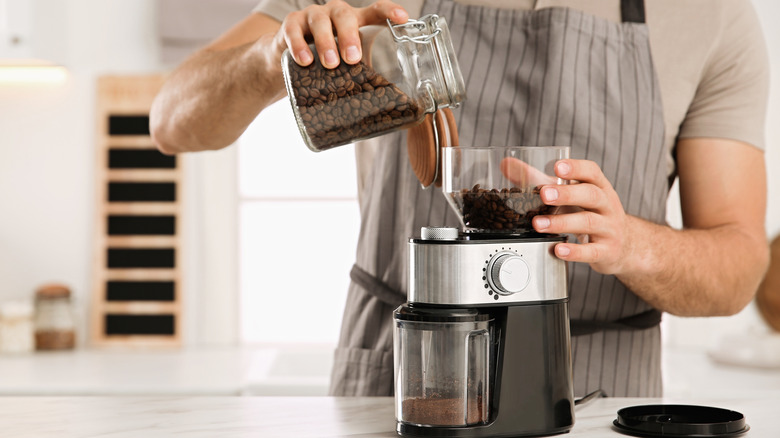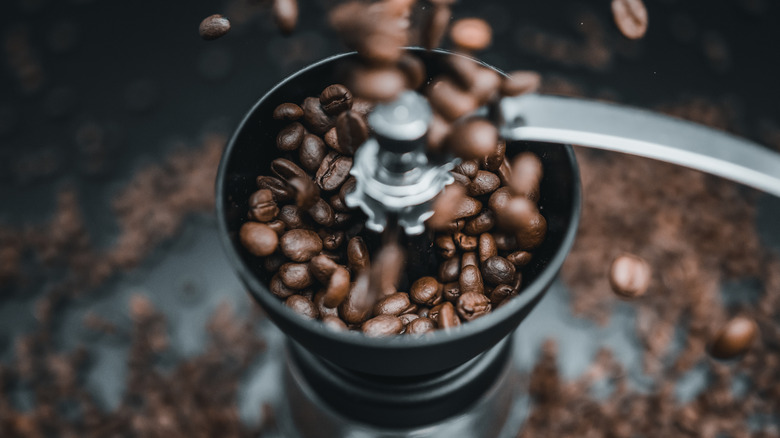The Coffee Grinder Mistake That Leads To Acidic Coffee
It's safe to say most people start the day off with a cup of coffee. Coffee aficionados swear by coffee, not just for its taste and seasonal versatility, but for its caffeine. According to Healthline, caffeine has numerous health benefits, such as boosting energy levels and reducing risks of diabetes and neurodegenerative disorders, such as Alzheimer's disease and Parkinson's disease.
Coffee is one of the most enjoyed beverages in the United States, according to Drive Research, which states that 75% of Americans drink coffee daily and over two-thirds of Americans make their coffee at home. Coffee can be enjoyed in many varieties, such as lattes, cappuccinos, macchiatos, and espressos.
Brewing coffee in the comfort of your home can not only can save you money, but grant you greater freedom in concocting coffee to your liking (yes, that means you can have pumpkin spice lattes all year round). But let's face it, not everyone is a seasoned barista. Sometimes, your coffee may not turn out the way you expect it to. Not a fan of acidic coffee? Fret not, it might just be your coffee grinder that's the problem.
It's all in the blades
Making coffee at home can be an extensive process. If you're feeling ambitious, grinding your own coffee beans (properly) leaves it fresher versus buying pre-ground coffee (via MasterClass). If you choose to grind your own coffee beans, then the perfect cup of joe may boil down to the blades of your coffee grinder. Low-quality blades can leave big pieces of coffee grounds, resulting in watery and acidic coffee. Experts agree that the right kind of grinder is the most important part of coffee-making. They suggest investing in quality blade grinders for an even blend of espresso beans (via Forbes).
For high-quality blades, coffee aficionados may want to invest in a burr grinder. A burr grinder has the ability to grind coffee grounds to be more refined. Other coffee grinders, such as blade grinders, usually only have one blade. Burr grinders, also known as burr mills, are made of two revolving metal surfaces, called burrs, that uniformly break down roasted coffee beans," said Nathanael Mehrens, inventor of Matchless Coffee Soda. Smaller coffee grounds tend to be less acidic, per Healthline.
Choose the right beans
The days of acidic coffee aren't necessarily over just because you own a burr grinder. There are other parts of the coffee-making process you need to pay attention to that may make your coffee acidic.
Just as the right coffee grinder is critical for a perfect cup of coffee, so are the right coffee beans. Dark roast coffee beans tend to be less acidic than light roast coffee beans (via Healthline). Some coffee brands even carry specialty low-acid coffee products. Roasting coffee beans at a lower temperature and duration can reduce their acidity, according to Perfect Brew. This process, known as white roasting, can also increase the caffeine content for an extra boost of energy.
Using hard water, which is water rich in minerals, as opposed to filtered water can help make coffee less acidic as well, per Perfect Brew. Do you like your coffee lower in acid with a little bit (or a lot) of milk? You may want to try adding almond milk to your cup. Almond milk is alkaline, which can balance out the acidity in coffee.


